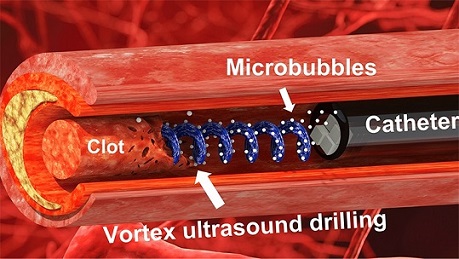Medical Innovations: North Carolina Scientist Develop Novel Vortex Ultrasound Enabled Endovascular Thrombolysis Procedure For Treating Brain Clots!
Medical Innovations - Vortex Ultrasound Enabled Endovascular Thrombolysis Feb 02, 2023 2 years, 10 months, 4 weeks, 20 hours, 27 minutes ago
Medical Innovations: With the incidence of COVID-19, Post COVID and also Post vaccine associated cerebral venous sinus thrombosis (CVST) skyrocketing globally, a new medical innovation by medical scientists from the North Carolina State University-USA could not have arrived at a more opportune time.

The research team have developed an ultrasound transducer that can disrupt blood clots in the brain quickly by creating an ultrasound vortex or ‘tornado’.
The novel transducer is designed to be housed in a catheter that can be advanced through the vasculature until it reaches the site of a blood clot in the brain, such as those that occur in cases of cerebral venous sinus thrombosis.
This new technique however can disrupt clots more quickly than conventional forward-facing ultrasounds, as the vortex wave creates shear stress that helps to break the clot into pieces more easily and rapidly.
The novel approach has the potential to disrupt clots much more quickly than pharmaceutical approaches, albeit with more procedural complexity.
CVST or cerebral venous sinus thrombosis (CVST) occurs when a blood clot blocks a vein that drains blood from the brain.
Studies have already shown that SARS-CoV-2 infections and also COVID-19 shots are driving the incidence of CVST globally.
https://www.thailandmedical.news/news/warning-scientists-from-shiraz-university-of-medical-sciences-confirm-that-cerebral-venous-sinus-thrombosis-cvst-incidences-are-high-as-result-of-covi
https://www.thailandmedical.news/news/warning-increasing-incidences-of-cerebral-venous-sinus-thrombosis-cvst-in-many-who-had-omicron-coincidences,-correlation-or-causal
https://janesthanalgcritcare.biomedcentral.com/articles/10.1186/s44158-021-00020-9
https://pesquisa.bvsalud.org/global-literature-on-novel-coronavirus-2019-ncov/resource/fr/covidwho-1023662
https://www.ahajournals.org/doi/10.1161/STROKEAHA.122.038955
https://www.neurores.org/index.php/neurores/article/view/697/662
https://www.ncbi.nlm.nih.gov/pmc/articles/PMC8554241/
https://www.ncbi.nlm.nih.gov/pmc/articles/PMC8800506/
ot;https://link.springer.com/article/10.1007/s12024-022-00458-5">https://link.springer.com/article/10.1007/s12024-022-00458-5
https://ejnpn.springeropen.com/articles/10.1186/s41983-022-00476-8
https://dergipark.org.tr/en/pub/jemcr/issue/64528/893939
https://www.ncbi.nlm.nih.gov/pmc/articles/PMC8578025/
https://www.cureus.com/articles/132609-extensive-cerebral-venous-sinus-thrombosis-post-covid-19-vaccination#!/
https://journals.lww.com/annals-of-medicine-and-surgery/Fulltext/2022/02000/Cerebral_venous_sinus_thrombosis_as_a_complication.86.aspx
https://www.mdpi.com/2076-393X/10/2/232
https://casereports.bmj.com/content/14/10/e246455
https://www.j-stroke.org/journal/view.php?number=430
https://www.jns-journal.com/article/S0022-510X(21)00226-4/fulltext
CVST or cerebral venous sinus thrombosis is typically a medical emergency where time is of the essence.
Many current techniques to treat the condition however involve trying to dissolve the clot, potentially through the use of clot busting drugs, but these approaches tend to take a long time.
Such latest
Medical Innovations aim to reduce this time significantly.
Dr Chengzhi Shi, a researcher involved in the study told Thailand
Medical News, “Based on available data, pharmaceutical interventions to dissolve CVST blood clots take at least 15 hours, and average around 29 hours. During
in vitro testing, we were able to dissolve an acute blood clot in well under half an hour. The fact that our new technique works quickly is important, because CVST clots increase pressure on blood vessels in the brain. This increases the risk of a hemorrhage in the brain, which can be catastrophic for patients.”
The research team said that utilizing acoustic waves to break clots apart has the potential to work much faster than thrombolytic drugs, but forward-facing ultrasound systems may not be the most efficient way to achieve this.
Dr Xiaoning Jiang, another researcher involved in the study also told Thailand
Medical News, “Our previous work looked at various techniques that use ultrasound to eliminate blood clots using what are essentially forward-facing waves. Our new work uses vortex ultrasound, where the ultrasound waves have a helical wavefront.”
To date, the research team have tested the system
in vitro with cow blood in a 3D-printed cerebral venous sinus model, and showed that the ultrasound tornado could disrupt clots quickly. They also tested if the helical ultrasound caused damage to blood vessels using animal blood vessels, and found that the technique appears not to disrupt healthy tissue.
Their study findings were published in the peer reviewed journal: Research (A Science Partner Journal).
https://spj.science.org/doi/abs/10.34133/research.0048
In their study abstract, the research team said that the aim of their study was to demonstrate this novel vortex ultrasound enabled endovascular thrombolysis method designed for treating cerebral venous sinus thrombosis (CVST).
Accordingly, this is a topic of significant importance since current treatment modalities for CVST still fail in as many as 20-40% of the cases and the incidence of CVST has increased since the outbreak of the COVID-19 pandemic.
When compared with conventional anticoagulant or thrombolytic drugs, sonothrombolysis has the potential to remarkably shorten the required treatment time owing to the direct clot targeting with acoustic waves.
To date however, previously reported strategies for sonothrombolysis have not demonstrated clinically meaningful outcomes (e.g., recanalization within 30 minutes) in treating large, completely occluded veins or arteries.
The study team demonstrated their new vortex ultrasound technique for endovascular sonothrombolysis utilizing wave-matter interaction-induced shear stress to enhance the lytic rate substantially.
Their invitro experiment showed that the lytic rate was increased by at least 64.3 % compared with the nonvortex endovascular ultrasound treatment.
The study findings showed that a 3.1 g, 7.5 cm long, completely occluded invitro 3D model of acute CVST was fully recanalized within 8 minutes with a record-high lytic rate of 237.5 mg/min for acute bovine clot in vitro.
In addition, the study findings confirmed that the vortex ultrasound causes no vessel wall damage over ex vivo bovine veins. This vortex ultrasound thrombolysis technique potentially presents a new life-saving tool for severe CVST cases that cannot be efficaciously treated using existing therapies.
For the latest on
Medical Innovations, keep on logging to Thailand Medical News.
